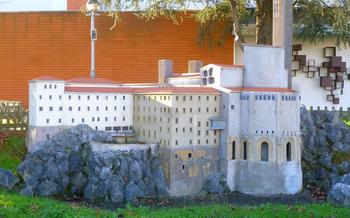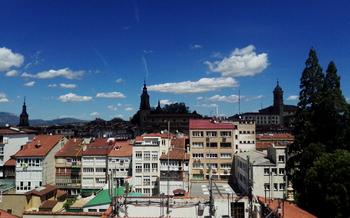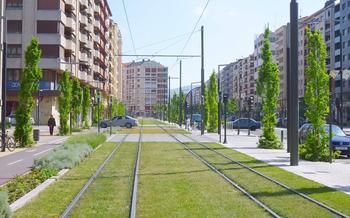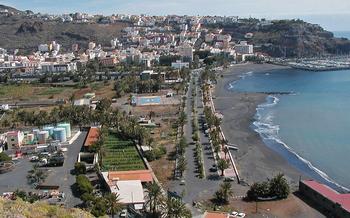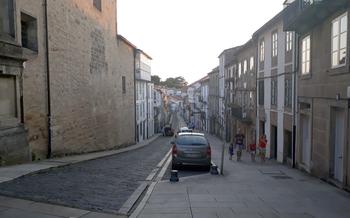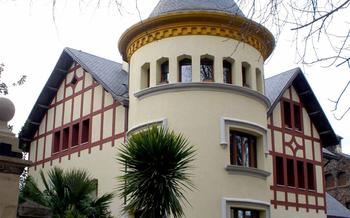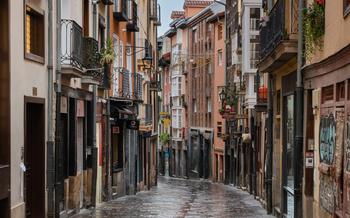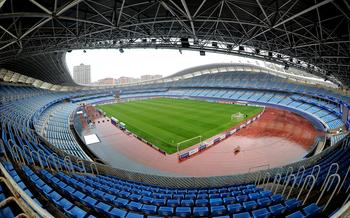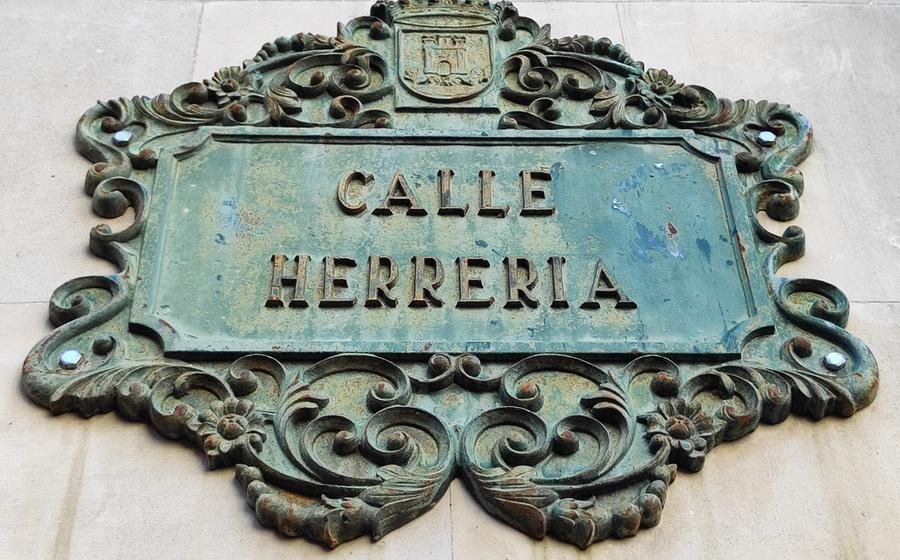
Sanctuary of Arantzazu
- A Sanctuary in the Mountains
- Architectural Masterpiece
- A Place of Pilgrimage
- Exploring the Interior
- The Altarpiece
- The Crypts
- The Museum
- The Surroundings
- Religious Festivals
- Accommodation
- Dining
- Shopping
- Accessibility
- Photography Tips
- Insider Tip: Embracing the Serenity of the Early Morning
A Sanctuary in the Mountains
Nestled amidst the breathtaking landscapes of the Aizkorri-Aratz Natural Park, the Sanctuary of Arantzazu stands as a testament to faith, art, and Basque heritage. Its origins date back to the 15th century, when a shepherd boy named Rodrigo de Balzategi claimed to have witnessed a vision of the Virgin Mary in a thorny thicket. This miraculous event led to the construction of a small hermitage, which over the centuries evolved into the magnificent sanctuary we see today.
The natural beauty of the surrounding park, with its lush forests, rolling hills, and towering peaks, creates a stunning backdrop for the sanctuary. Visitors are captivated by the harmony between the sanctuary's architecture and the natural environment, as if the building itself had grown organically from the landscape. The legend of the Virgin of Arantzazu, deeply rooted in Basque culture, adds a mystical aura to the sanctuary, attracting pilgrims and visitors alike who come to pay homage to the Virgin and seek spiritual solace.
The sanctuary is open to the public daily, offering free admission to all visitors. Whether you're a pilgrim seeking spiritual enlightenment, an art enthusiast marveling at the architectural masterpiece, or simply a traveler drawn to the beauty of the natural surroundings, the Sanctuary of Arantzazu promises an unforgettable experience.
Architectural Masterpiece
The Sanctuary of Arantzazu stands as a testament to the harmonious fusion of Basque and modern architectural styles. Designed by renowned architects and artists such as Francisco Javier Sáenz de Oiza and Jorge Oteiza, the sanctuary boasts unique features that set it apart from other religious structures in the region.
The exterior facade, adorned with intricate carvings and sculptures, showcases a blend of traditional Basque motifs and contemporary artistic expressions. The use of local materials, such as sandstone and iron, lends an organic feel to the structure, integrating it seamlessly into the surrounding natural landscape.
The interior of the sanctuary is equally captivating, with its soaring ceilings, expansive stained glass windows, and meticulously crafted artwork. The altarpiece, a masterpiece of Basque art, takes center stage, mesmerizing visitors with its intricate carvings and vivid depictions of religious scenes.
The sanctuary's design seamlessly merges functionality with aesthetics, creating a space that is both awe-inspiring and inviting. It serves as a testament to the skill and vision of the architects and artists who collaborated to bring this architectural masterpiece to life.
A Place of Pilgrimage
The Sanctuary of Arantzazu holds immense religious significance as a pilgrimage site, attracting numerous pilgrims from across the Basque Country and beyond. The devotion to the Virgin of Arantzazu, known as the "Ama Birjina" or "Mother Virgin," has deep roots in Basque culture and history. Pilgrims undertake journeys to the sanctuary to seek blessings, offer prayers, and pay homage to the Virgin Mary. Throughout the year, the sanctuary hosts various religious celebrations and events, including masses, processions, and festivals. These events draw large crowds of pilgrims and visitors who come to celebrate and participate in the vibrant religious traditions of the Basque people. The sanctuary serves as a spiritual center for the Basque community, providing a place for reflection, devotion, and connection with their cultural and religious heritage.
Exploring the Interior
Stepping inside the Sanctuary of Arantzazu is like entering a realm of ethereal beauty and spiritual awe. The sanctuary's interior is a testament to the artistry and devotion that went into its creation. The stained glass windows, sculptures, and intricate carvings create a symphony of light, color, and form that transports visitors to a higher plane.
The stained glass windows, crafted by renowned Basque artists, depict scenes from the life of the Virgin Mary and other religious figures. The vibrant colors and intricate details of the windows fill the sanctuary with a kaleidoscope of light, casting a warm glow on the interior.
Equally impressive are the sculptures and artwork that adorn the sanctuary's walls and altars. These works of art, created by some of the finest Basque and Spanish artists, depict religious scenes with remarkable realism and emotion. The sculptures seem to come alive, capturing the essence of the characters they represent and evoking a sense of wonder and devotion.
The intricate carvings that embellish the sanctuary's interior add to its overall grandeur. From the delicate tracery of the altarpieces to the intricate patterns on the choir stalls, every surface seems to be adorned with exquisite carvings. These carvings, often depicting religious symbols and motifs, contribute to the sanctuary's rich symbolism and create a sense of awe and reverence.
The overall effect of the sanctuary's interior is one of serene beauty and spiritual enlightenment. The harmonious blend of stained glass, sculpture, and carving creates a space that invites contemplation and reflection, inspiring visitors to connect with their faith and find solace and tranquility within these sacred walls.
The Altarpiece
At the heart of the Sanctuary of Arantzazu lies its awe-inspiring altarpiece, a masterpiece of Basque art and a testament to the sanctuary's religious significance. Crafted with meticulous precision, the altarpiece serves as the focal point of the sanctuary's interior, captivating visitors with its intricate carvings and profound symbolism.
The altarpiece's central panel depicts the Virgin of Arantzazu, the sanctuary's patron saint, surrounded by a host of angels and saints. The intricate carvings showcase the Virgin's serene beauty and convey a sense of divine grace and majesty. The surrounding panels narrate scenes from the life of Christ, offering a visual representation of the sanctuary's central religious themes.
Beyond its artistic beauty, the altarpiece holds profound theological significance. Each element, from the Virgin's posture to the expressions of the saints, carries symbolic meaning, inviting visitors to contemplate the mysteries of faith and the interconnectedness of the divine and the human. The altarpiece serves as a powerful reminder of the sanctuary's role as a place of pilgrimage and spiritual reflection, where visitors can seek solace, inspiration, and a deeper connection with their faith.
The Crypts
Beneath the Sanctuary of Arantzazu lies a hidden realm of solemnity and remembrance - the crypts. These hallowed chambers serve as the final resting place for various religious figures and prominent Basque personalities who have left an indelible mark on the region's history and culture.
Descending into the crypts, visitors are greeted by an atmosphere of quiet reverence. The air is heavy with the weight of history and the echoes of prayers that have reverberated through these sacred spaces for centuries. The walls are adorned with intricate carvings and decorative elements that pay homage to the lives and legacies of those interred within.
Among the most notable figures laid to rest in the crypts is Blessed Fray Andrés de Urdaneta, a Basque explorer and Augustinian friar who played a pivotal role in the Spanish exploration of the Pacific Ocean. His remains were brought to Arantzazu in 1908, and his tomb has become a place of pilgrimage for those seeking inspiration and guidance.
The crypts also house the tombs of several bishops and archbishops who served the Basque Country with unwavering devotion. Their contributions to the spiritual and cultural well-being of the region are etched in the very stones of these sacred chambers.
Exploring the crypts is a somber yet profoundly moving experience. It is an opportunity to pay respects to those who have shaped the history of the Basque Country and to reflect on the enduring legacy of faith and tradition that binds this community together.
The Museum
Within the sacred complex of the Sanctuary of Arantzazu, a treasure trove of history and art awaits discovery at the museum. This repository of religious artifacts, historical documents, and exquisite artwork unveils the rich tapestry of the sanctuary's past and its profound impact on Basque culture. Interactive exhibits and educational resources enhance the visitor experience, providing a deeper understanding of the sanctuary's significance. Through the museum's dedicated efforts, the cultural and religious heritage of this sacred site is meticulously preserved and showcased for generations to come.
The Surroundings
Beyond the spiritual and architectural wonders of the Sanctuary of Arantzazu, the surrounding landscapes beckon with their captivating beauty and offer a plethora of outdoor activities. Immerse yourself in the breathtaking scenery of the Aizkorri-Aratz Natural Park, a haven of unspoiled nature that envelops the sanctuary. Lace up your hiking boots and embark on invigorating trails that wind through lush forests, ascend rugged peaks, and unveil panoramic vistas that will leave you spellbound. Let the tranquility of nature soothe your soul as you breathe in the invigorating mountain air and witness the kaleidoscope of colors that dance across the landscape with each changing season.
Discover the charm of the nearby villages and towns, where Basque culture and traditions flourish. Stroll along cobblestone streets lined with quaint shops, savor delectable local cuisine in traditional restaurants, and immerse yourself in the vibrant atmosphere of lively festivals and celebrations. Discover the rich history and heritage of the Basque Country as you explore its captivating museums, churches, and historic sites. Whether you seek serenity in nature or the warmth of Basque hospitality, the surroundings of the Sanctuary of Arantzazu offer an unforgettable tapestry of experiences.
Religious Festivals
The Sanctuary of Arantzazu is a focal point for religious celebrations and festivals throughout the year. One of the most significant festivals is the Feast of the Assumption, held on August 15th. This festival commemorates the assumption of the Virgin Mary into heaven and attracts thousands of pilgrims and visitors. During the festival, there are solemn processions, special masses, and a vibrant festive atmosphere.
Another important festival is the Feast of the Immaculate Conception, held on December 8th. This festival celebrates the conception of the Virgin Mary without original sin. Similar to the Feast of the Assumption, there are processions, masses, and a festive ambiance during this time.
For those seeking a more immersive experience, the Holy Week processions are a must-see. During Holy Week, the streets surrounding the sanctuary come alive with processions depicting the Passion of Christ. These processions are a testament to the deep religious traditions of the Basque people and offer a unique opportunity to witness the devotion and passion of the local community.
To make the most of your visit during religious festivals, it's advisable to plan ahead and book accommodation in advance, as the sanctuary attracts a large number of visitors during these times. Attending these festivals offers a glimpse into the rich religious heritage of the Basque Country and provides a chance to connect with the local culture on a deeper level.
Accommodation
When planning your visit to the Sanctuary of Arantzazu, finding suitable accommodation is crucial. Fortunately, there are various options to suit different budgets and preferences near the sanctuary. For a comfortable and convenient stay, consider booking a room at one of the nearby hotels. These hotels offer a range of amenities, including comfortable rooms, delicious dining options, and easy access to the sanctuary. Alternatively, guesthouses and bed and breakfasts provide a more intimate and homely experience. These establishments often offer personalized service and a chance to interact with local hosts.
To secure the best deals and avoid disappointment, it's advisable to book your accommodation in advance, especially during the peak season. Take advantage of online booking platforms and travel websites to compare prices, read reviews, and find the best deals. If you're on a tight budget, consider staying in one of the nearby towns or villages, where you can find more affordable options while still being within easy reach of the sanctuary.
Dining
When planning your visit to the Sanctuary of Arantzazu, don't miss the opportunity to indulge in the culinary delights of the Basque region. The area surrounding the sanctuary is home to several excellent restaurants that offer a taste of traditional Basque cuisine.
For an authentic Basque dining experience, be sure to try some of the region's signature dishes, such as pintxos (Basque tapas), bacalao al pil pil (cod fish with garlic and chili peppers), and txuleta (grilled steak).
Many restaurants in the area also offer a wide selection of local wines, allowing you to pair your meal with the perfect accompaniment.
Whether you're looking for a casual meal or a fine dining experience, you're sure to find something to your taste in the restaurants near the Sanctuary of Arantzazu.
Here are a few recommendations to get you started:
- Asador Etxebarri: A Michelin-starred restaurant known for its innovative take on traditional Basque cuisine.
- Casa Julián: A family-run restaurant serving classic Basque dishes in a warm and inviting atmosphere.
- Borda Berri: A charming restaurant located in a traditional Basque farmhouse, offering stunning views of the surrounding countryside.
- Bar Nestor: A popular spot for pintxos, with a wide variety of options to choose from.
- La Taberna del Gourmet: A cozy wine bar with a great selection of local wines and Basque tapas.
No matter where you choose to dine, be sure to savor the flavors of the Basque Country and enjoy the warm hospitality of its people.
Shopping
The Sanctuary of Arantzazu offers a unique opportunity to purchase mementos and souvenirs that reflect the spirituality and cultural significance of the site. In the sanctuary's gift shop, visitors can find a treasure trove of handcrafted items, religious souvenirs, and other keepsakes that serve as a reminder of their pilgrimage or visit.
Among the popular souvenirs are intricately carved wooden figures depicting scenes from the life of the Virgin Mary, rosaries made with local materials, and ceramic tiles adorned with images of the sanctuary. Visitors can also find books, postcards, and other publications that provide a deeper insight into the history, architecture, and religious significance of the sanctuary.
To support local artisans and the community, it is recommended to purchase souvenirs directly from the sanctuary's gift shop rather than from third-party vendors. The proceeds from the sale of souvenirs help maintain the sanctuary and its facilities, ensuring its preservation and accessibility for future generations.
Beyond the sanctuary's gift shop, visitors can explore the surrounding towns and villages to discover unique souvenirs and local products. Local markets and artisan shops often showcase the talents of local craftspeople, offering handmade jewelry, pottery, and textiles that reflect the Basque culture and traditions.
Accessibility
Ensuring that every visitor can experience the beauty and sacredness of the Sanctuary of Arantzazu, the site features several accessibility features to accommodate individuals with disabilities. Wheelchair ramps and elevators have been strategically placed throughout the complex, allowing for easy navigation between different levels. Accessible restrooms have also been thoughtfully designed to provide a comfortable and dignified experience for visitors with special needs. For those seeking further assistance, the sanctuary's friendly staff is always ready to lend a helping hand, providing wheelchairs and guiding visitors through the sanctuary's grounds and interior. With these accessibility features in place, the Sanctuary of Arantzazu welcomes everyone to come and bask in its spiritual and architectural splendor.
Photography Tips
Capture the grandeur: Use wide-angle lenses to capture the scale and grandeur of the sanctuary's architecture. Experiment with different perspectives to create dynamic compositions.
Play with light: The sanctuary is beautifully illuminated at different times of the day. Visit during sunrise or sunset to capture the warm, golden light that casts a magical glow on the stone façade.
Explore the details: Don't just focus on the overall structure. Look for intricate details like carvings, stained glass windows, and sculptures. Close-up shots can reveal the craftsmanship and artistry that went into every corner.
Seek unique angles: Step away from the main viewpoints and explore hidden nooks and crannies. Look for interesting angles that showcase the sanctuary's unique features and create a sense of depth.
Embrace the reflections: Take advantage of the reflective surfaces around the sanctuary, such as the water features and the polished stone floors. Reflections can add depth and interest to your photographs.
Insider Tip: Embracing the Serenity of the Early Morning
As the sun casts its first golden rays upon the Sanctuary of Arantzazu, a sense of tranquility envelops the surroundings. Embrace the magic of the early morning hours, when the sanctuary awakens from its slumber, and immerse yourself in its serene atmosphere. Stroll through the peaceful grounds, marveling at the intricate details of the architecture as they emerge from the shadows. Capture the ethereal beauty of the sanctuary bathed in the soft morning light, creating photographs that will forever remind you of this mystical experience. Let the serenity of the early morning seep into your soul, allowing you to connect with the spiritual essence of this sacred place in a profound and meaningful way.
